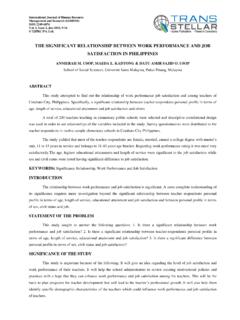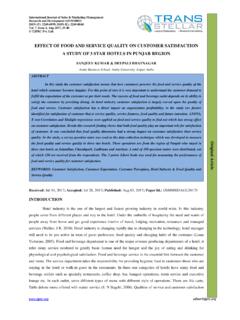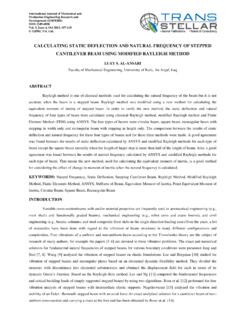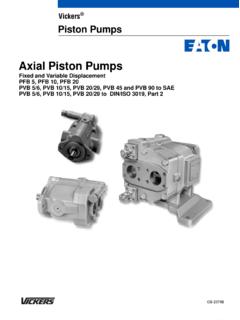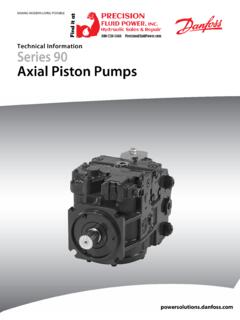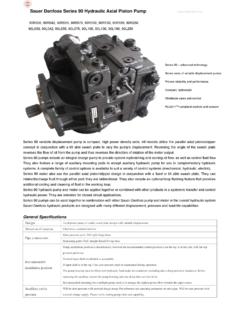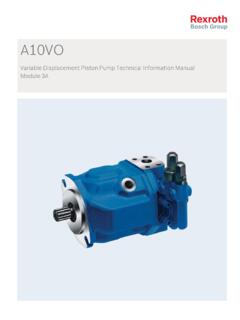Transcription of DESIGN AND ANALYSIS OF A BRAKE CALIPER - TJPRC
1 DESIGN AND ANALYSIS OF A BRAKE CALIPER DHANANJAY PHAD1, TEJAS AUTI2, RUCHA JOSHI3 SWAPNIL JADHAV4 & SAGAR DEVASTHALI5 1,2,3,4 Department of Mechanical Engineering, College of Engineering, Pune, Maharashtra, India 5 Department of Production Engineering & Industrial Management, College of Engineering, Pune, Maharashtra, India ABSTRACT Effective braking is a critical factor determining the performance of any vehicle. With enhancement in the performance, need of an effective braking system increases.
2 BRAKE CALIPER being the heart of a braking system, the whole system is built considering its strength. An optimized DESIGN of a BRAKE CALIPER thereby ensures reduced size of wheel assembly, reduced weight and effective braking. This paper studies a conceptual DESIGN of a BRAKE CALIPER for an All-Terrain Vehicle (ATV), primarily focusing on reducing the size and weight without compromising its strength, stiffness and low piston drag. Computer aided DESIGN model of a BRAKE CALIPER is created in Creo and analyzed for stress and deformation in ANSYS Workbench KEYWORDS: FEA, BRAKE CALIPER , Braking System, piston Drag, ATV, piston Retraction, Creo , ANSYS Workbench , Braking Torque INTRODUCTION In braking, a BRAKE CALIPER plays a very important role as the final clamping force on a BRAKE rotor is applied by the friction pads held by CALIPER .
3 When driver applies brakes, pressure is applied on the back side of piston pushing the friction pads against BRAKE rotor resulting in frictional force on BRAKE rotor and slows the vehicle down. A general layout of a double piston floating CALIPER is shown in Figure 1. Figure 1: Exploded View of a BRAKE CALIPER 1. CALIPER body 2. Mounting bracket International Journal of Automobile Engineering Research and Development (IJAuERD) ISSN(P): 2277-4785; ISSN(E): 2278-9413 Vol. 5, Issue 5, Oct 2015, 1-10 TJPRC Pvt. Ltd. 2 Dhananjay Phad, Tejas Auti, Rucha Joshi, Swapnil Jadhav & Sagar Devasthali Impact Factor (JCC): Index Copernicus Value (ICV): 3.
4 piston 4. Retraction Seal 5. Scrapper Seal 6. Friction Pads 7. Bleed point 8. Fluid inlet A BRAKE CALIPER which is mounted on upright mainly holds the friction pads, while the clamping force is applied by the piston . The pressure distribution over the friction pads must be uniform so as to ensure even pad wear and heat distribution. Braking torque generated being the key parameter in braking, must be greater than the torque required to stop the vehicle. This is achieved by applying clamping force on the BRAKE rotor which causes reactive forces thereby inducing stresses in the CALIPER body. The applied clamping force results in frictional force and generates heat which is dissipated by rotor and pads the kinetic energy of a vehicle is converted into heat which increases the disc temperature.
5 This heat may be transferred to the CALIPER body through the BRAKE pads causing thermal deformation. TYPES OF CALIPERS Depending on working mechanism Floating CALIPER fixed or Opposed piston CALIPER Floating CALIPER In a floating CALIPER , piston is on the inboard side of the CALIPER while the CALIPER is mounted on a guiding pin which acts as a cylindrical support. The guiding pin allows linear movement of the CALIPER along its axis. The friction pads on the outboard side are continuously in contact with the BRAKE rotor which prevents the bending of the rotor. When BRAKE pedal is actuated, the pressure is applied on back side of the piston which forces the friction pads against the rotor.
6 The reaction force forces the CALIPER to slide over the guide pin leading to clamping of the rotor. fixed CALIPER fixed type CALIPER has pistons on both sides of the rotor and can be directly fixed to the mountings on the uprights. Pistons from both the sides force the friction pads to apply force on BRAKE rotor. fixed CALIPER does not require extra mounting bracket which is necessary in floating type CALIPER for sliding. The major advantage of fixed CALIPER over a floating CALIPER is the even wear of the friction pads. A floating BRAKE CALIPER is generally preferred as it has multiple advantages over the fixed CALIPER .
7 The piston being only on inboard side occupies less space on the outboard side. As the number of pistons is half of that of the fixed CALIPER s, it is light in weight and has less leakage prone points. In a fixed type CALIPER , BRAKE fluid is on both the sides which causes more temperature rise in fluid as compared to a floating type CALIPER resulting in greater evaporation of fluid. Ease of manufacturing is an added advantage of floating type CALIPER . DESIGN and ANALYSIS of a BRAKE CALIPER 3 Depending on Number of Pistons Number of pistons in a CALIPER significantly affects its performance.
8 Calipers can be made with single or multiple pistons depending upon torque requirement and space availability. For vehicles requiring less braking torque, single piston can be used. But, with increasing torque requirement the bore diameter becomes considerably large increasing the size of the CALIPER . Hence, the number of pistons needs to be switched to two or three depending upon the requirement. The only disadvantage of using double or triple piston CALIPER is added number of leakage sources. Another factor that affects performance of a CALIPER is pad wear. It seems that pressure exerted by the pads is even over the pad area but it does not happen in practice.
9 The side from which the rotor enters the CALIPER is called the leading side, while the side from which the rotor exits the CALIPER is the trailing side as shown in Figure 2. Figure 2: Leading and Trailing Side When the pads are pressed against the rotor, it tries to turn the pads as well because of which the area on the leading side experiences larger forces. This causes excessive heat generation in the leading area of the friction pad resulting in more wear. Single piston CALIPER shows least uneven wear pattern throughout the friction pad, which can be further reduced by providing a small offset between the axes of the piston and the friction pad on the leading side.
10 In calipers with multiple pistons, pad area is greater along the circumference of disc resulting in significant uneven wear. In multi- piston calipers the pistons are different in diameter such that the smaller piston is on the leading side and the greater one on the trailing side. Depending on CALIPER Body BRAKE CALIPER can be made as a single body called monobloc CALIPER or in two parts called split type CALIPER . The major problem in a CALIPER being deflection under the application of clamping force, the CALIPER is made in two parts and then joined together by bolts. The position of these bolts must be close to the piston centerline so that the deflection is minimal.


